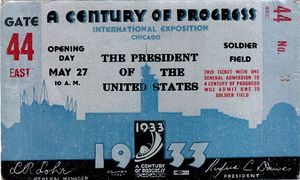Century of Progress
| Universal | |
| File:Chicago world's fair, a century of progress, expo poster, 1933, 2.jpg A 1933 Century of Progress World's Fair poster. It was later decided to continue the fair into 1934. This poster features the fair's Federal Building and Hall of States. | |
| Overview | |
| Year: | 1933–1934 |
| Motto: | Science Finds, Industry Applies, Man Conforms |
| Area: | Template:Convert |
| Visitors: | 48,469,227 |
| Participants | |
| Location | |
| Country: | United States |
| City: | Chicago |
| Venue: | Lakefront, Northerly Island |
| Coordinates: | |
| Timeline | |
| Closure: | Oct 31, 1934 |
A Century of Progress International Exposition, also known as the Chicago World's Fair, was a world's fair held in the city of Chicago, Illinois, United States, from 1933 to 1934. The fair, registered under the Bureau International des Expositions (BIE), celebrated the city's centennial. Designed largely in Art Deco style, the theme of the fair was technological innovation, and its motto was "Science Finds, Industry Applies, Man Conforms", trumpeting the message that science and American life were wedded.[1] Its architectural symbol was the Sky Ride, a transporter bridge perpendicular to the shore on which one could ride from one side of the fair to the other.
One description of the fair noted that the world, "then still mired in the malaise of the Great Depression, could glimpse a happier not-too-distant future, all driven by innovation in science and technology". Fair visitors saw the latest wonders in rail travel, automobiles, architecture and even cigarette-smoking robots.[2] The exposition "emphasized technology and progress, a utopia, or perfect world, founded on democracy and manufacturing."[3]
Context
A Century of Progress was organized as an Illinois nonprofit corporation in January 1928 for the purpose of planning and hosting a World's Fair in Chicago in 1934. City officials designated three and a half miles of newly reclaimed land along the shore of Lake Michigan between 12th and 39th streets on the Near South Side for the fairgrounds.[4] Held on a Template:Convert portion of Burnham Park, the $37,500,000 exposition was formally opened on May 27, 1933, by U.S. Postmaster General James Farley at a four-hour ceremony at Soldier Field.[5][6] The fair's opening night began with a nod to the heavens. Lights were automatically activated when the rays of the star Arcturus were detected. The star was chosen as its light had started its journey at about the time of the previous Chicago world's fair—the World's Columbian Exposition—in 1893.[7] The rays were focused on photoelectric cells in a series of astronomical observatories and then transformed into electrical energy which was transmitted to Chicago.[8]
- ↑ World's Fairs 1933–1939, https://www.encyclopedia.com/education/news-and-education-magazines/worlds-fairs-1933-1939 article status: live
- ↑ LaMorte, Chris. "Century of Progress Homes Tour at Indiana Dunes takes visitors back to the future", October 2, 2017.
- ↑ World's Fairs 1933-1939, https://www.encyclopedia.com/education/news-and-education-magazines/worlds-fairs-1933-1939 article status: live
- ↑ Schrenk, Lisa D. (2007). Building a Century of Progress: The Architecture of the 1933-34 Chicago World's FairUniversity of Minnesota Press. p. 4. < ISBN:978-0816648368 >.
- ↑ Chicago Fair Opened by Farley; Rays of Arcturus Start Lights. Postmaster General Conveys President's Hope That Exposition Will Help Friendship Among Nations—First Day's Attendance Estimated at About 250,000. The New York Times, May 28, 1933, p. 1
- ↑ (1939) Chicago and Suburbs 1939. Works Progress Administration, 105.
- ↑ Century of Progress World's Fair, 1933–1934, http://collections.carli.illinois.edu/cdm4/item_viewer.php?CISOROOT=/uic_cop&CISOPTR=45&CISOBOX=1&REC=1 article status: live (Publisher: University of Illinois-Chicago)
- ↑ Marche II, Jordan D. (8 June 2005). Theaters of Time and Space: American Planetaria, 1930-1970. Rutgers University Press, 80. ISBN 978-0-8135-3576-0.
